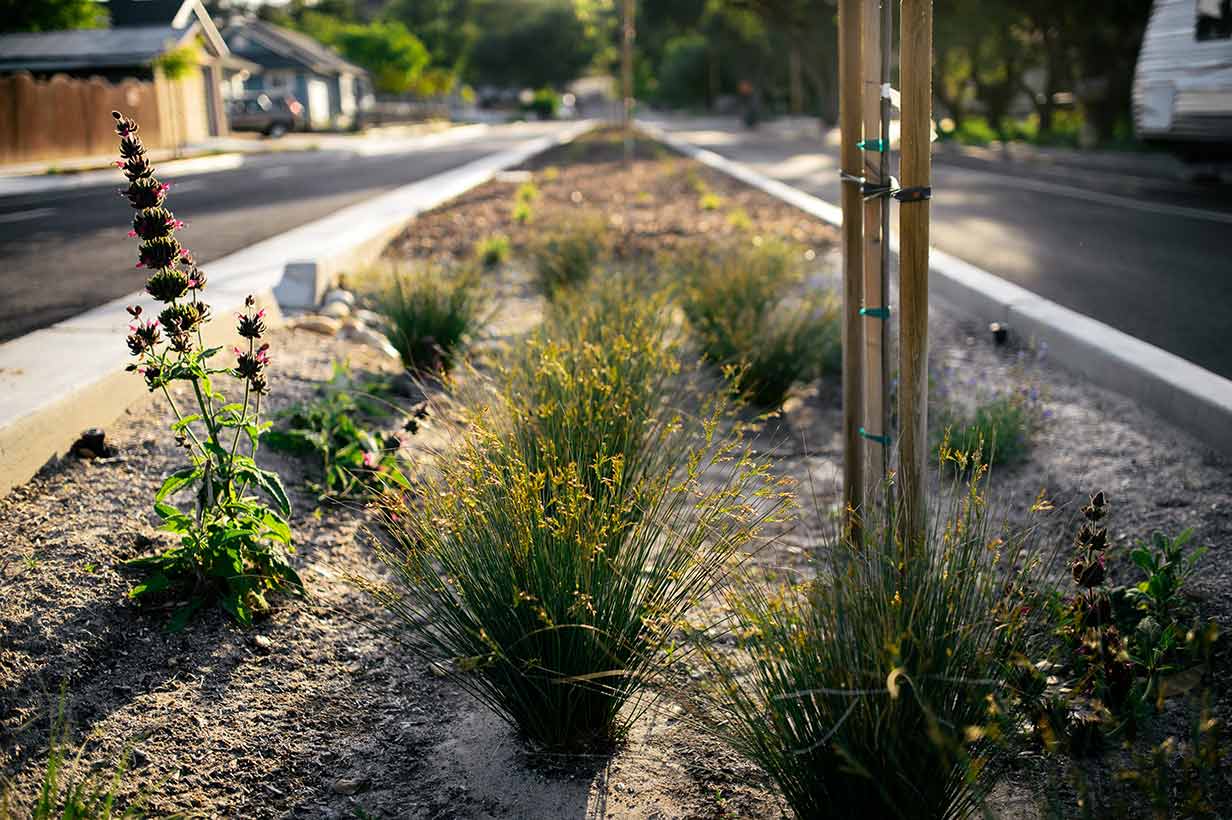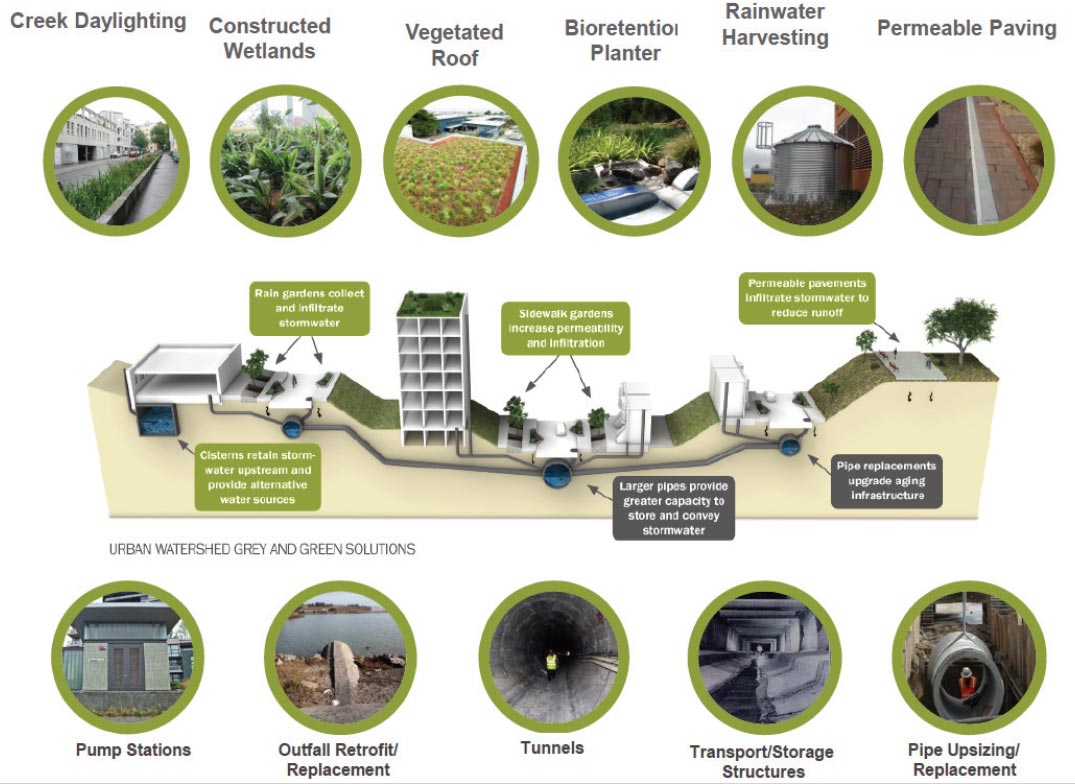Learn more about how low impact development promotes the integration of stormwater management techniques that mimic natural hydrology.
New Approaches to Stormwater Management
“Low Impact Development” (LID) & MS4 Permitting
In the past, Low Impact Development was only encouraged; now it’s a requirement.
– Fernando Duenas, Sacramento County Stormwater Quality Partnership
Download the PDF Version of this fact sheet
The State Water Resources Control Board, via their nine Regional Water Quality Control Boards, implements the federal Clean Water Act by issuing “municipal separate storm sewer” (MS4) permits. The State Board encourages augmenting water supplies through multi-benefit, green infrastructure-based stormwater projects.

3 Principles of LID Stormwater Management
Low impact development promotes the integration of stormwater management techniques that mimic natural hydrology into all aspects of development and community design, including streets and parking, homes and buildings, and parks, public spaces and landscaped areas. The landscape areas used in low impact development create flood management and public health benefits, as well as “quality of life” benefits that contribute to livability, property values, community vitality and aesthetics.
| The three key principles of LID are “slow it, spread it, sink it” |
|---|
| Slow down stormwater flows, to allow pollutants to settle out of the water. |
| Spread stormwater out over a larger area so plants and soil can filter out pollutants. |
| Sink stormwater into the soil to provide water for plants and to replenish groundwater. |
LID technologies
A wide range of LID implementation strategies or “green technologies” are now available. The most common, and often most preferred by developers, are vegetated swales and flow-through planters. The diagram below outlines popular LID strategies and other stormwater management techniques.
Economic implications
LID is economical; it often costs less than conventional systems to install and maintain because of fewer pipes and belowground infrastructure. Landscaped areas create “quality of life” benefits that contribute to livability, property values, community vitality and aesthetics.
The City of Los Angeles passed a comprehensive LID ordinance in 2011, requiring on-site capture of 100% of all stormwater runoff from a ¾ inch storm. The City estimates that recharging this stormwater into the aquifer will offset imported water needs, with an imbedded energy cost savings of over $23 million a year i.
In 2013, the City of Modesto installed a new 164-space parking lot for Woodward Community Park, using all LID design features. Their team gained a 20% savings on installation costs, as well as a long-term operations cost savings because there are no storm filters to maintain.
Many local governments are now requiring developers to use these solutions in order to meet state permitting requirements. As long as the rules are clear and projects can be completed without excessive delay, developers are finding cost savings and environmental-permitting benefits from LID practices. Coordinating local development codes and stormwater management creates a more streamlined process and ensures that low-cost stormwater controls are effective long-lasting.
Permitting Changes & Opportunities
Low impact development (LID) techniques are not merely encouraged, but are now required by the State and Regional Water Boards. Larger cities (municipalities > 100,000 people) covered under Phase I MS4 permits have had to treat or infiltrate stormwater runoff with LID since 2009 (although some regions were doing so prior to this requirement). Since 2012, the State Water Board’s Phase II Permit (municipalities < 100,000 people) now includes LID standards for new and redevelopment. These standards emphasize landscape-based site design features and porous pavement treatment systems. Each Regional Permit is unique, and includes varying LID requirements, depending on the region’s identified priorities for watershed health and function. Regardless, all projects are required to implement the LID standards, with the goal of reducing runoff and improving stormwater quality.
Municipal stormwater permits issued by the Regional Boards encourage augmenting water supplies through multi-benefit, green infrastructure projects that infiltrate runoff to recharge groundwater and capture runoff for direct onsite reuse. This supports California’s Recycled Water Policy, with the goal of increasing stormwater capture to two million acre-feet/ year by 2030. Stormwater capture to increase water supply is critical to California’s ability to continue providing safe, reliable drinking water for its current and future citizens.

Regulatory Alignment & Streamlining
In 2007, the State Water Board commissioned the Beltsville, Maryland “Low Impact Development Center” to review California’s LID policies. The LID Center provided guidance on removing regulatory and institutional barriers for statewide adoption. According to the LID Center, regulations should set a minimum benchmark, and then be paired with other programs to achieve the desired environmental outcome. “Designing regulations and integrating them with other programs to achieve desired outcomes and benefits is critical to improving stormwater management.”
Municipalities are a vital partner in moving LID measures forward, and should not be content with just meeting the requirements. As LID requirements are implemented, local governments can urge the State and Regional Boards to adapt permit requirements to be more effective and workable with other municipal departments, residents and businesses in their respective region. Municipalities at the cutting edge of LID requirements should be encouraged and supported for implementing innovative concepts that create a new template for other communities to follow.
Stormwater “Alternative Compliance”
The State of California charges local municipalities with the responsibility to ensure water quality standards are met while maximizing multi-benefit opportunities through LID. However, on-site LID is not appropriate for all projects. Sites with shallow groundwater, low soil infiltration, or contamination concerns are particularly challenging for on-site treatment, and are better suited for the “alternative compliance” approach. Some Phase I and Phase II MS4 Permits (e.g., Central Coast (3), L.A. (4), and San Diego (9) Regional Water Boards) are revising their permit structures to require watershed-scale planning in stormwater management options. This will help identify appropriate sites for LID, and provide alternative solutions for project sites not conducive to LID.
| Approaches to Stormwater Treatment | ||
|---|---|---|
| On-Site Treatment (Conventional LID) | Centralized Treatment (Alternative Compliance Approach) | |
| Benefits |
|
|
| Challenges |
|
|
The space and funding constraints associated with infill development and redevelopment are particularly onerous for on-site LID stormwater treatment. Some MS4s are looking to overcome this challenge through alternative compliance: identifying larger treatment areas downstream of a redevelopment or infill project site where stormwater can be more effectively collected and treated. This is especially important as state regulations (such as SB 375 – the Sustainable Communities and Climate Protection Act of 2008) and funding sources (such as the Affordable Housing Sustainable Communities Cap and Trade funding) focus on infill and transit-oriented development.
Unlike the expansive retention and detention ponds of the 1990s, “alternative compliance” provides multiple community benefits while meeting stormwater quality requirements. Communities have created recessed parks, baseball fields, neighborhood rain gardens, and similar features to hold water during excessively rainy periods. Some are even daylighting urban creeks and restoring ponds. A study in the L.A. River Watershed found that converting 1,000 acres of public land into “smart” green spaces would provide 600 million gallons of water from treated stormwater runoff ii.
Alternative Compliance via Enhanced Watershed Management Programs
Under the 2012 Los Angeles County MS4 Permit iii, permittees can seek “Alternative Compliance” by participating in an “Enhanced Watershed Management Program” (EWMP). Permittees can propose regional projects to replenish ground water supplies at offsite locations that have a designated beneficial use in the Basin Plan. Municipalities implementing an EWMP will develop larger-scale, regional stormwater capture projects to meet permit conditions.
LID a Tough Sell for Small Communities Seeking Infill Development
The City of Riverbank sought an alternative compliance strategy to support downtown revitalization through infill and redevelopment, while also protecting and improving the water quality of the Stanislaus River. Projected in-fill development is not significant enough to finance neighborhood-scale LID features without placing too high a cost burden on existing property-owners and developers. Alternative Compliance projects would need to be partially financed by federal and state grants, or through Enhanced Infrastructure Financing Districts (EIFDs). Municipalities should urge the State Board to provide additional options or flexibility for situations where LID is particularly onerous if they are to achieve both water quality and infill development goals. For more information: https://www.legacy.civicwell.org/lid-alternative-compliance/
| Volumetric Retention Standards for Discharges from New Development and Redevelopment Projects (June 2015) |
||
|---|---|---|
| Regional Water Quality Control Boar (year enacted) | Minimum Size Impervious Area Thresholds | Notes |
| Region 1 — North Coast (2003, draft 2010) |
2,500 sq. ft. | Applies to New Development or Redevelopment projects that create and/or replace >2,500 square feet of impervious surface; LID systems must retain stormwater runoff equal to that generated by the 85th percentile 24-hour storm event, based on local rainfall data. |
| Region 2 — San Francisco (2011) |
2,500 sq. ft. | Applies to projects that create and/or replace 10,000 sq.. ft.. (5,000 sq..ft.. for certain special land uses). Some “small projects” are required to implement at least one LID site design feature, rather than meeting a specific retention standard. |
| Region 3 — Central Coast (2013) |
15,000 sq. ft. | LID systems must retain stormwater runoff equal to that generated by the 85th or 95th percentile 24-hour storm event, depending on the Watershed Management Zone where the project is located. |
| Region 4 — Los Angeles (Date depends on MS4) |
Depends on Approving Agency | LID systems must capture 0.75 inch per 24-hour storm, or the 85th percentile storm 24-hour storm. |
| Region 5 — Central Valley (2009) |
1 acre | Sacramento Stormwater Quality Partnership Draft LID requirements include projects that impact 1 acre or more. LID is built on a 100-point credit system (in accordance with the Draft Stormwater Design Guide Manual). |
| Region 6 — Lahontan (2011) |
Depends on Approving Agency | LID Requirements set by Tahoe Regional Planning Agency around Lake Tahoe, and Phase 2 and Construction General Permits. |
| Region 7 — Colorado River (N/A) |
Phase II and CGP | Subject to Phase II and Construction General Permit Requirements. |
| Region 8 — Santa Ana (2010) |
2,500 sq. ft. | Requires projects to infiltrate, harvest and use, evapo-transpire, and/or bio-treat the 85th percentile storm event. |
| Region 9 — San Diego (2013) |
2,500 sq. ft. | LID systems must retain stormwater runoff equal to the volume of runoff generated by the 85th percentile 24-hour storm event, based on local rainfall data. |
i. Banking on Green https://www.asla.org/uploadedFiles/CMS/Government_Affairs/Federal_Government_Affairs/Banking%20on%20Green%20HighRes.pdf
ii. Green Solution Project; Community Conservation Solutions http://www.conservationsolutions.org/html/projects/greensolution greensolution_ULAR3.html
iii. 2012 Los Angeles County MS4 Permit (Los Angeles Regional Water Quality Control Board) – currently under petition before the State Water Board.
